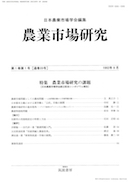Volume 7, Issue 2
Displaying 1-6 of 6 articles from this issue
- |<
- <
- 1
- >
- >|
-
Article type: Article
1999Volume 7Issue 2 Pages 1-11
Published: March 31, 1999
Released on J-STAGE: March 28, 2019
Download PDF (1170K) -
1999Volume 7Issue 2 Pages 12-15
Published: March 31, 1999
Released on J-STAGE: March 28, 2019
Download PDF (435K) -
1999Volume 7Issue 2 Pages 16-21
Published: March 31, 1999
Released on J-STAGE: March 28, 2019
Download PDF (630K) -
Article type: Article
1999Volume 7Issue 2 Pages 22-32
Published: March 31, 1999
Released on J-STAGE: March 28, 2019
Download PDF (1295K) -
Article type: Article
1999Volume 7Issue 2 Pages 33-42
Published: March 31, 1999
Released on J-STAGE: March 28, 2019
Download PDF (1081K)
-
1999Volume 7Issue 2 Pages 43-45
Published: March 31, 1999
Released on J-STAGE: March 28, 2019
Download PDF (368K)
- |<
- <
- 1
- >
- >|
